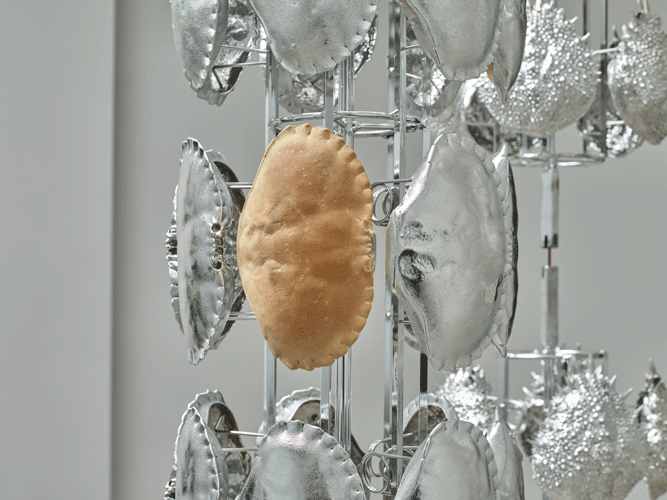

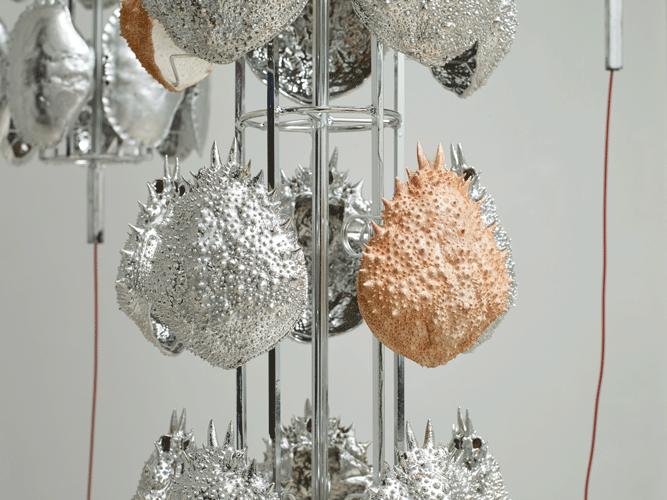
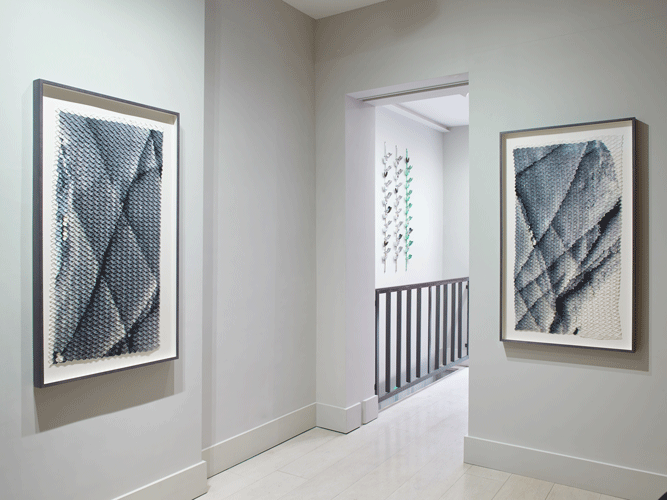
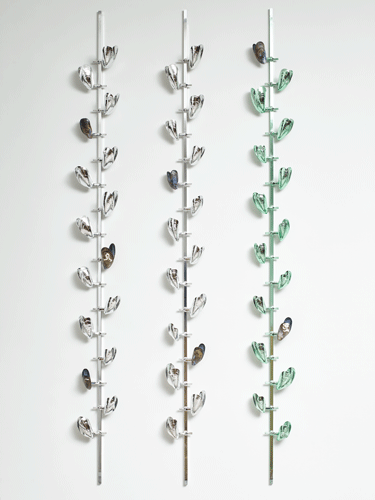
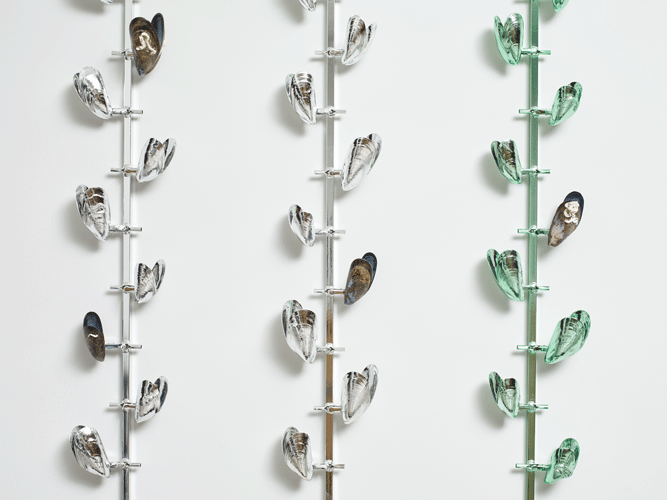



A Coin In Nine Hands: Part Five
Alice Channer (Carapaces)
22 Mar—28 Apr 2018Marguerite Yourcenar’s novel, A Coin in Nine Hands (1934), follows the journey of a ten-lira coin as it travels between nine different people on a single day in Rome in 1933.
Inspired by this idea, Large Glass presents the work of a range of artists across nine parts or exhibitions over the coming nine months, revealing connections, exchanges, and highlighting some of the hidden bonds that bring artists together.
Alice Channer is a British sculptor whose work combines traditional and modern production processes to offer a synthetic replacement for both natural and industrial forms. For part five of A Coin in Nine Hands, Channer has created new work from pleated fabrics, rocks and the shells of crustaceans and bivalves, all of which she refers to as ‘carapaces’: a tough skin or cover that implies some sort of protective coating or shield. Channer writes: “Each work is an attempt to make visible the moment that these carapaces both touch and detouch industrial processes”.
A pair of artist books, Skinned and Detouched, is published during the exhibition and launched at the gallery on 26 April. Below is an except from Jennifer Boyd’s writing on Channer’s work:
The carapaces are not welded or bolted. They are held tenderly by jig fixings that hook inside their shells and use a spring to create a feeling of tension. It is a satisfying metal into strange, light, organic oval, crunching dried light. There are 20-28 crabs per carousel, each gently jigged underneath. If near a source of heat your body would mummify. If not you would eventually freeze. If you were to freeze in space your body would crack into pieces. The crack of a knife in the back of a crab. Bones cracking. Ice cracking. Like a piece of china. Cross sections of skin bone muscle frozen in time. The temperature in the vacuum metalliser is 330 degrees. There cannot be any air hidden in the object. Because under vacuum conditions. Air expands and so would rupture the terrific tranquillity of the metalicised surface. This is also why you shouldn’t hold your breath when you go to space. A lungful of air will not survive under those conditions. Will rupture the smooth friction less sliding sacs of your lungs.
Inspired by this idea, Large Glass presents the work of a range of artists across nine parts or exhibitions over the coming nine months, revealing connections, exchanges, and highlighting some of the hidden bonds that bring artists together.
Alice Channer is a British sculptor whose work combines traditional and modern production processes to offer a synthetic replacement for both natural and industrial forms. For part five of A Coin in Nine Hands, Channer has created new work from pleated fabrics, rocks and the shells of crustaceans and bivalves, all of which she refers to as ‘carapaces’: a tough skin or cover that implies some sort of protective coating or shield. Channer writes: “Each work is an attempt to make visible the moment that these carapaces both touch and detouch industrial processes”.
A pair of artist books, Skinned and Detouched, is published during the exhibition and launched at the gallery on 26 April. Below is an except from Jennifer Boyd’s writing on Channer’s work:
The carapaces are not welded or bolted. They are held tenderly by jig fixings that hook inside their shells and use a spring to create a feeling of tension. It is a satisfying metal into strange, light, organic oval, crunching dried light. There are 20-28 crabs per carousel, each gently jigged underneath. If near a source of heat your body would mummify. If not you would eventually freeze. If you were to freeze in space your body would crack into pieces. The crack of a knife in the back of a crab. Bones cracking. Ice cracking. Like a piece of china. Cross sections of skin bone muscle frozen in time. The temperature in the vacuum metalliser is 330 degrees. There cannot be any air hidden in the object. Because under vacuum conditions. Air expands and so would rupture the terrific tranquillity of the metalicised surface. This is also why you shouldn’t hold your breath when you go to space. A lungful of air will not survive under those conditions. Will rupture the smooth friction less sliding sacs of your lungs.
Alice Channer
Press
The Telegraph, ‘Alice Channer celebrates the intricate shape of the shell at Large Glass’, Louisa Buck, 6 April 2018
Press
The Telegraph, ‘Alice Channer celebrates the intricate shape of the shell at Large Glass’, Louisa Buck, 6 April 2018